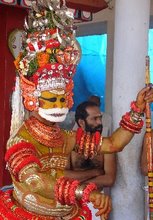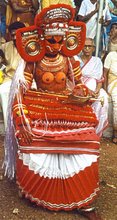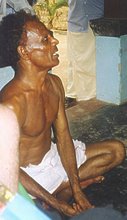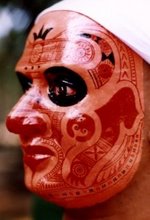MORE ABOUT THEYYAM
Theyyam is an artistic dance form where metaphysical thoughts and expressions of immortal souls are impersonated to a believer through a mortal body. Theyyam originated from "Kaliyattam" once practiced by the tribal community of north Kerala. Theyyam had grown to the present form through many transformations since it’s origin. Landlords and chieftains of those days are the main forces behind many of such transformations. The community and its body began to use this art to propagate the major theme of social enforcement. The artists are also encouraged by the authorities to introduce new themes into its traditional layers and classified different acts and expressions to match specific needs for their desire. The character representations were very broad. They range from mild to wild in representations. Theyyam is a sect in which old heroes are sanctified and worshipped as the guardians of villages and homes. Yet, it includes a complex universe centered on the belief that a man can—after suitable mental, physical and spiritual preliminaries—don the costume of a particular deity and then become that deity. In this elevated state he assumes superhuman and divine powers—speaking, moving, blessing and even healing as a god or goddess. What is crucial is that the person is not possessed by the spirit of the deity.
ESSENCE OF THEYYAM
The essence of Theyyam is like the enhancement of the efficacy of a "manthra" by its incremental repetition. It brings us a super temporal and superabundance feeling in spite of its inherent relationship with real life at its inception. In the case of Theyyam, when the spirit is propitiated, the living generations enlightened in them the purest and the loftiest intentions that the past represents. The articulate creation of masks and gears from natural sources are intended to make unknowns to known and unattainable to real. The dancer recreates its mythical and ritualistic imagination and systematically delivers the right moods through his body posters. The performer of Theyyam gets himself completely into the artistic rhythm. Even when the dancer breaks coconut against his forehead, cuts his forehead with the sword, or wears red-hot iron chain on his body as a mark of self-torture, he never goes out of rhythm. The person who performs Theyyam while delivering such metaphysical experiences and involves himself completely into the act traverses through three different stages. The first stage is one kind of impersonation by decorating himself with creative paintings and coverings made up of natural materials. The second stage helps him to involve a mental state of flight to mystic heights. The last stage is the accomplishments of the dancer submerged fully into the artistic rhythm of acting the story. Though the spectators feel that the actor is unconscious to the surroundings, the man who controls the technique of dance and rhythm in him is fully alive to the situation. In theatre acting, if the actor looses his control, the act is rated as substandard. Myths in their visual manifestations react to their physical environment and absorb the colors and forms from nature and transport them into a philosophy and emotion of exhaustion and sublimation. It's important to understand that Theyyam has a larger purpose that goes beyond the territories of performance - to all those in attendance, it assures assistance and security during times of crisis, promising to resolve all their conflicts. Which is why the current trend of adapting it to suit a new context is viewed with distaste.
DIVINE TOUCH OF THEYYAM
After the preliminary rituals, which are often complex and intense, an empowered man-don’s elaborate mask-like make up. The wearing of spectacular costume further enhances the illusion of becoming a divine being. The unique quality of Theyyam is that its deities can manifest themselves in the bodies of empowered men as dancer-performers, and appear before their devotees while interacting with them by answering questions, mocking the pompous, ridiculing the vain, and humiliating the arrogant. Many of the male gods are associated with Shiva, and the goddesses with Parvati. There are about 450 deities in the pantheon of Theyyam. Some are worshipped under different names in different localities, making it difficult to be exact about their numbers. Many of these have evolved out of the land, lives, social customs, and traditions of the devotees. Some are deified ancestral warrior heroes whose extraordinary exploits were seen as evidence of divinity. The same is true for the goddesses who lived and suffered as mortal women, and were later recognized as innocent and divine, such as Nharmbhil Bhagavathi and Muchilotu Bhagavathi. The performance is always preceded by preliminary rituals. Certain deities are initially honored with the tottam, or song ritual, when the artist, wearing a simple costume and with minimal makeup, sings the song that relates not only to the deity's myth, but also to the origins of his or her relationship with the particular shrine. For the more active warrior gods, a vellattam, or energetic ritual dance incorporating martial arts, is required. After this the performer will retire to a temporary structure to be made up and costumed as the actual Theyyam. When the moment comes, he will enter the shrine to complete the ancient and complex process that has already begun edging him out into an extraordinary otherness. The most sacred and powerful element of the costume, the mudi or headdress, is put on once the artist has been seated on a sacred stool in front of the sanctum. After this comes the actual moment of "becoming" the deity, the moment of crossing the line, as he stares into a small hand-held mirror. It is at this point that, almost imperceptibly, he slips into another state of being, his eyes widening as they focus not on his own reflection, but on the enigmatic features of a divine being. This is the moment of fusion, the defining moment known as mukhadarshanam, or the seeing of the face. It is the moment when a mortal becomes a god.
THEYYAM PERFORMER
‘Theyyam’ performers belong to one of the Hindu communities. Each individual caste has the right to perform certain deities and all performers must poses a wide range of extraordinary skills. They must know the ritual and character of every deity. They have the inherited right to perform, know-how to sing, dance with the drum, do the complicated make-up and dress their costumes. Theyyam artistes are male. It is not a profession or calling that can be adopted. The artist's shrine rights are always inherited from the mother's family and when he marries, he also acquires the shrine rights of his wife's family. The artistes share a common training and tradition in which the process of becoming the deity is achieved after intense mental, physical and spiritual preparation. All Theyyam artistes must be able to do much more than just perform. Every deity's physical appearance conforms to an image envisaged centuries ago in the dream or vision of a respected guru. An artist must know how to make the headdresses and costumes of all the deities, how to apply the face and body makeup in all the different styles and designs, how to sing, play the drums, and know the stories, songs, and character of each deity.
DEAR ALL, JUST CREATED A BLOG RELATED FAMOUS RITUAL DANCE OF NORTH MALABAR AREA OF KERALA STATE IN INDIA. YOU ARE MOST WELCOME ON YOUR OPINION ABOUT THIS WEBSITE
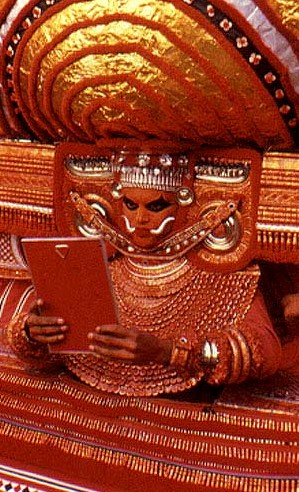
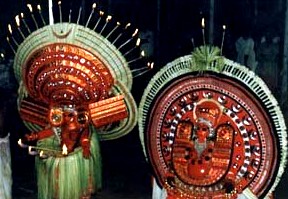
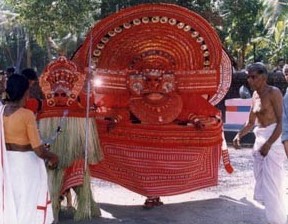
![]()
